
Vegan fitness and nutrition coach Karina Inkster helps you adopt two powerful healthy living habits: a plant-based diet and a consistent strength training routine. Here’s your starter kit for long-term success.
January: the traditional goal-setting month for many of us. This year, I’d like to challenge you to take a slightly different approach. Instead of making a goal-based resolution, resolve to create habits.
It just so happens that I went vegan on January 1. It was not meant to be a New Year’s resolution, which is one of the many reasons I’m still vegan, 16 years later.
Vegan and fit—for life
Making the transition to veganism and incorporating strength training into your daily life are two of the most powerful lifestyle habits you can adopt.
A vegan diet also has a significant positive impact on the environment. Steering clear of animal agriculture—one of the world’s largest sources of greenhouse gas emissions—means lowering your carbon footprint. Plant-based diets require much less energy, water, and fertilizer than diets containing animal products.
The Academy of Nutrition and Dietetics states that, when properly planned and executed, vegan diets are “healthful” and “nutritionally adequate.” They make sure to point out that vegan diets are “appropriate for all stages of the life cycle,” including pregnancy, childhood, and older adulthood.”
This means you can start at any age! Taking steps to eat more plant-based foods and fewer animal products will positively affect your health at all stages of life.
The same goes for fitness. You can start at absolutely any age and make incredible progress. Aim to keep the habits you add small and sustainable. This way, you’ll set yourself up for lifelong results, and you’ll learn to love the daily processes involved in achieving your health and fitness goals.
Create new—vegan—nutrition habits
Making the transition to veganism doesn’t have to be complicated, and it doesn’t have to happen all at once. In keeping with our theme of habits, here’s my approach to going vegan: begin with the start of your day and work your way down. This could take a few weeks or a few months, but it ensures you build solid habits at each step.
Breakfast
Start by “veganizing” your breakfast. Try overnight oats or cooked oatmeal topped with fruit; tofu scramble; or a berry, flax, and chia seed smoothie.
Lunch
Once vegan breakfasts are your “new normal” (once the habit is established), move on to lunches. These can be as simple as a PB&J sandwich or hummus with fresh veggies, or more elaborate like a “Buddha bowl” of black beans, cabbage, grated beets, and tempeh over a bed of brown rice and drizzled with tahini dressing.
Dinner
Give yourself a few weeks, then move on to dinners. The options are endless! In our household, chili, stir-fries, minestrone soup, and enchiladas are winter staples.
Support your fitness with vegan nutrition
Food quality, calories, and macronutrients are the three nutrition concepts most vital to supporting your fitness.
Food quality
High quality foods are those in their most natural states (whole grains, fresh produce) and are high in micronutrients (vitamins and minerals).
Preparing most of your meals in your own kitchen and focusing on filling your plate with as many whole foods as possible will ensure you’re eating a nutrient-dense diet that fuels your fitness goals.
Calories
Work with a nutrition professional to help you set calorie and macronutrient goals. Calories—a measure of the energy we get from food—are important for both athletic performance and physique goals.
You need to ensure you’re consuming an appropriate amount of energy for your fitness endeavours, while also supporting your physique goals. You’ll need to take in less energy than you burn if you’re looking to lose fat, and more energy than you burn if you’re working on gaining muscle.
Macronutrients
Macronutrients are the nutrients our bodies need in the largest amounts: carbohydrates, proteins, and fats. Each has a different function in our bodies, and we each need different ratios of these nutrients, depending upon our lifestyles and training.
Most of my vegan clients who strength train aim to get half their calories from carbohydrates (whole, nutrient-dense sources whenever possible), 25 to 30 percent from healthy fats, and 20 to 25 percent from protein.
Avoid these common mistakes
There’s no one right way to go vegan—you can make the transition in whatever way best suits your lifestyle. However, there are a few mistakes to avoid.
Mistake #1: Cutting out animal products without replacing them
Replace animal products with a variety of whole, plant-based foods to prevent nutritional deficiencies. Focus on sources of protein such as tofu, tempeh, beans, nutritional yeast, nuts, and seeds.
Mistake #2: Fostering a mindset of avoidance
Challenge yourself to create a mindset of abundance, rather than one of avoidance. Instead of focusing on all the foods you can’t eat, focus on all the new foods you can eat more of, including those you haven’t yet tried. (I had no idea what tempeh, amaranth, farro, or wakame were before I went vegan!)
Mistake #3: Neglecting to optimize your food environment
Your “food environment” is your environment and the habits you’ve built that determine what—and how—you eat. Try scheduling some time each week to prepare a large batch of a healthy vegan entrée and some grab ‘n’ go snacks to reduce the amount of cooking required during the week.
How to create your fitness plan
Along with a whole foods, plant-based diet, regular resistance training is a must for optimal health, fitness, and disease prevention. Resistance workouts most often involve strength training at the gym, but you can also complete bodyweight, resistance band, or suspension trainer workouts at home. Here are some tips.
- If you’re just starting out, aim for three 30-minute strength training sessions per week. Once you’ve maintained this habit for about two months, you can increase the length of your workouts to 45 minutes.
- If your schedule allows, you can also increase your training to four days per week, working upper body and lower body on alternating days.
- To ensure you’re using correct form, I recommend working with a trainer until you’re confident you can perform each lift effectively.
- When creating your workout program, make sure you’re training all the fundamental movement patterns at least twice a week: squat, hip hinge, lunge, upper body push, upper body pull, and loaded carry. Our workout provides an example of each.
- I’ve suggested a “strength standard” for each move, to help you with your goal- and habit-setting. Consider them suggestions rather than prescriptions. Targets like these can give you an idea of what you can work on and are achieved by most lifters within six to 12 months of regular (three to four days per week) workouts.
- Don’t forget that habits are at the core of getting results. If you plan to work toward these strength standards, turn them into habits to ensure success. For example, instead of saying, “I’ll deadlift 100 percent of my bodyweight for 10 reps by the end of 2019,” try “I’ll practise deadlifts two days per week for all of 2019, and aim to increase the weight by five to 10 pounds every month.”
Vegan fitness: Common myths and truths
Myth:
Plants are subpar protein sources.
Truth:
Plants contain all the amino acids (building blocks of protein) our bodies need. As long as you’re eating a variety of whole plant foods, the protein you need is not hard to get.
Myth:
Going vegan will help me lose weight.
Truth:
A whole foods vegan diet certainly can help you lose weight, but it’s a calorie deficit, not a vegan diet, that’s responsible. Weight maintenance, as well as muscle gain, is possible on a vegan diet.
Myth:
Going vegan will decrease my athletic performance.
Truth:
The opposite may be true! Eating an abundance of plant-based anti-inflammatory foods (containing antioxidants and phytochemicals) may aid in recovery from training.
The simplest way of getting a reasonably accurate idea of your calorie consumption and macronutrient ratios is to track your food in an app such as MyFitnessPal.
Workout
Aim for three sets of 10 to 12 reps per exercise, with a weight that feels very challenging by rep 7. For the weighted carry, aim to walk about 30 metres (40 to 50 steps).
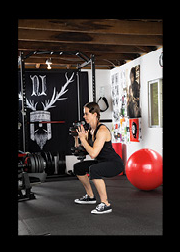 Movement 1: Squat
Movement 1: Squat
Example: Goblet squat
Target: Quads, glutes, hamstrings
Strength standard: 40 percent of your bodyweight for 10 reps
The squat is one of the most effective lower body exercises. It builds muscle and strength, as well as hip mobility.
- Stand with your feet a bit wider than shoulder width, holding a dumbbell (by one end) at chest level.
- Keeping your chest up and your back flat, hinge your hips back and down, bending your knees so your thighs are parallel to the floor. Keeping your knees in line with your toes, press into the floor with your feet to return to standing.
Movement 2: hip hinge
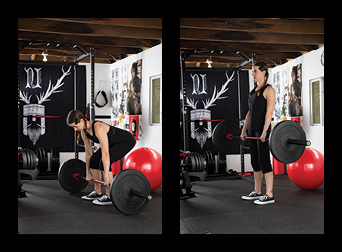
Example: Deadlifts
Target: Hamstrings, glutes, low and upper back
Strength standard: 100 percent of your bodyweight for 10 reps
Deadlifts engage all the muscles of the posterior chain (the back of your body).
- Stand with feet shoulder-width apart, arms straight, with your shins almost touching a barbell on the floor. Elevate the bar on blocks if needed; the bar should be at mid-shin level).
- Hinge your hips behind you and bend your knees, keeping your back flat and your head in line with your spine as you grab the bar.
- Press your heels into the floor and drive your hips forward to return to standing.
Movement 3: lunge
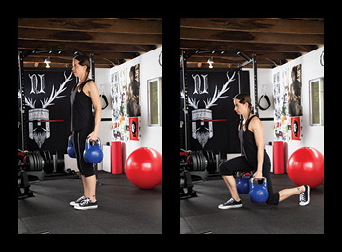
Example: Reverse lunge
Target: Quads, glutes, hamstrings
Strength standard: 50 percent of your bodyweight for 10 reps (25 percent of your bodyweight in each hand)
Lunges develop foot, ankle, knee, and hip stability, in addition to strengthening your legs.
- Stand tall with your feet shoulder-width apart, holding a dumbbell or kettlebell in each hand.
- Step your right foot back, bending both knees until your right knee is almost in contact with the floor. Both legs should be at a 90-degree angle.
- Press through your left heel to return to the start position. Repeat for reps, then switch to the other side.
Movement 4: upper body push
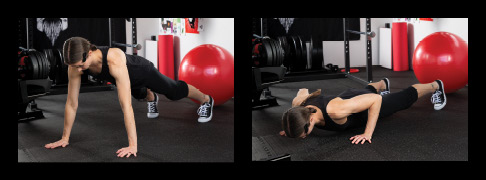
Example: Push-up
Target: Chest, shoulders, core
Strength standard: 10 full push-ups in a row
The push-up is the most fundamental upper body pushing movement to master. It engages your entire core and teaches proper body alignment.
- Start in a plank position with your hands positioned under your shoulders. Your body should form a straight line from your head to your heels.
- Maintain this plank position as you lower yourself and bring your nose within an inch of the ground. Press back up into the start position.
Movement 5: upper body pull
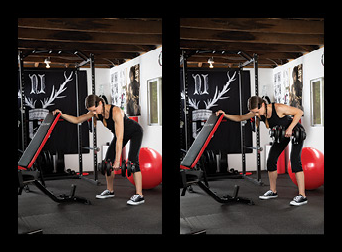
Example: 3-point dumbbell row|
Target: Back, core
Strength standard: 35 percent of your bodyweight for 10 reps
Rows strengthen the major muscles in your back, which can help to improve your posture. By using only one hand on the bench (instead of kneeling on it), your core muscles work hard to resist torso rotation.
- Holding a dumbbell in one hand, hinge your hips back, bend your knees, and place your other hand on the end of a bench.
- Keeping your back flat and abs braced, pull the dumbbell up your side until your elbow is just above your torso.
- Lower the weight with control, and repeat for reps.
Movement 6: loaded carry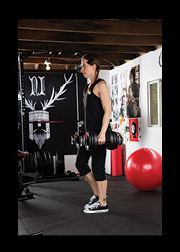
Example: Farmer’s walk
Target: Entire core musculature, shoulders, back
Strength standard: 80 percent of your bodyweight for a distance of 40 metres (40 percent of your bodyweight in each hand)
This often overlooked movement is a must to stay pain and injury free. It increases grip strength, builds muscle, and translates well into everyday movements (such as carrying heavy shopping bags!).
- Grab a pair of heavy dumbbells or kettlebells.
- Brace your core and the muscles in your back and shoulders, and slowly walk.
- Squeeze your shoulder blades together and keep the muscles of your upper body and core engaged throughout.





































